This was published 7 years ago
How Hobart became a mainlander’s dream
In Tasmania's capital, outsiders are buying boltholes, developers are circling and tourism is soaring. But not everyone's benefiting from the city’s boom.
By Gabriella Coslovich
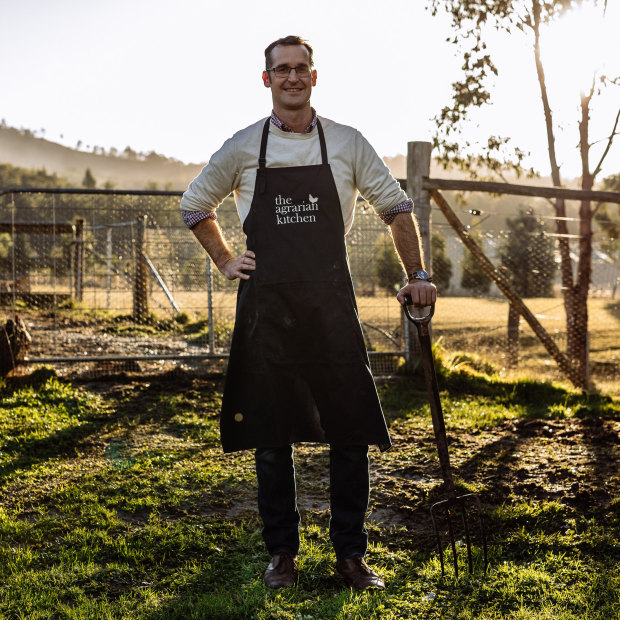
Rodney Dunn of New Norfolk eatery The Agrarian Kitchen.Credit: Adam Gibson
"This won't be as exciting as meeting David Walsh,” real estate agent Kim Morgan says as we head out for a spin through some of Hobart’s best streets. We’ve been chatting about my get-together with Walsh in 2007, when he was yet to become a household name and his Museum of Old and New Art was still a big hole in the ground. The millionaire gambler had picked me up from the airport in a silver convertible Mercedes.
"Depends what car you drive," I reply. "Is that your Maserati?" I point to a sleek blue sports car parked on the street. Good guess.
I slide into the leather-upholstered passenger seat of Morgan's 2004 coupe. The engine purrs as he glides up Salamanca Place and through historic Battery Point on Hobart's waterfront, the heartland of the city's blue-chip real estate. Morgan is a tall and lean 50-year-old, dressed in a snappy, slim-fitting suit of textured blue. His face is lightly tanned; his hair has the sandy glow of someone who spends a lot of time outdoors. At 5.30am today he was out rowing on the River Derwent – only a five-minute drive from his home in South Hobart.
"The lifestyle is fantastic," he says of the city he's lived in since he was five, when his family moved here from Sydney. Twenty-odd years ago, Morgan "lured" his wife-to-be southward from Sydney. "It's okay, she loved me," he says with a grin. She must have. Back then, Hobart was not the place on which to hedge your romantic bets. How things have changed.
When in January 2011 Walsh opened MONA in working-class Berriedale in the city's north, no one could have predicted the astonishing effect it would have on Tasmania's economy and Hobart's international status. MONA sparked a renaissance; it made Hobart cool, Walsh its unlikely hero. In the ensuing seven years, tourism to the state has soared; in the past year, the growth rate of international visitors was higher than that of any other state, albeit off a low base (only the Australian Capital Territory receives fewer people). Chinese President Xi Jinping dropped by in 2014 – and was photographed patting a Tasmanian devil joey – prompting a flood of Chinese tourists, culminating in 34,600 visitors from China in the 12 months to September 2017, up 40 per cent on the year prior.
"What MONA did brilliantly was instil a new confidence into Tasmanians and how we projected ourselves in the world," says Tourism Tasmania's chief executive officer, John Fitzgerald. "Perhaps we'd been seen as a bit of a cultural backwater until that point. David Walsh disrupted the market so much that it shifted people's thinking about that really quickly."
Backwater no longer. MONA and its seasonal arts and music festivals – Mona Foma and Dark Mofo – drew a new cohort to Tasmania: sophisticated, cashed-up, pleasure-seeking cultural tourists. They came and were swept away by Hobart’s natural beauty; a city curled between the Derwent River and the intense backdrop of majestic Mount Wellington (since 2014, officially called kunanyi/Mount Wellington). They breathed air that is among the purest in the world; they enjoyed the (relatively) free-flowing traffic and the quality of local produce; and they started to notice the affordable housing. Is it any wonder many began to dream of moving here?
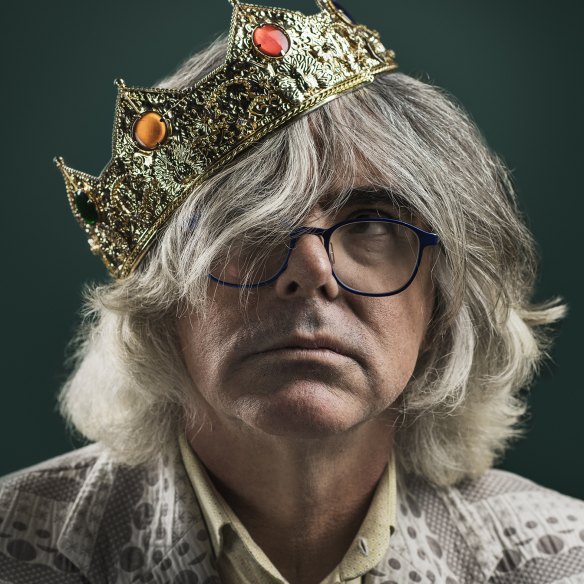
David Walsh, the man behind MONA.Credit: Nic Walker
These days, it can sometimes seem as though everyone’s buying into Hobart’s enviable “lifestyle”, from celebrity chefs enticed by the flourishing food scene to families seeking relief from the mainland’s impossibly priced houses, to wine producers and “climate refugees” escaping the heat. Local Chinese Buddhist leader Master Xin-De Wang, from the Holy Tantra Esoteric Buddhism community, got in early, moving to Tasmania in 1999 after leaving China in 1989. The community reportedly now owns 13 properties in Hobart, many in the city’s best suburbs and streets, including the $3 million Winmarleigh mansion, in waterside Taroona, where monks reside.
"It's about this time of year, every year, that we start getting enquiries from South Australia and Western Australia," Morgan says. "When it starts getting really hot over there, the phones start ringing. Particularly older people, often with an English accent."
Hobart is the epicentre of the state's real estate growth, with house prices jumping 13.4 per cent last year, making it the strongest performing capital city in the country, and the fastest, with homes typically selling in 20 days or less. But they're still, on average, far cheaper than those of mainland capital cities. Waimea House, a spectacular Federation Arts and Crafts-style house in Sandy Bay, bought by Hobart-born investment banker and art collector Greg Woolley in 2012, holds the city's record at $8.5 million. Compare that to the $70 million-plus paid for Australia's dearest house, Point Piper estate "Elaine", sold by the Fairfax family in April 2017.
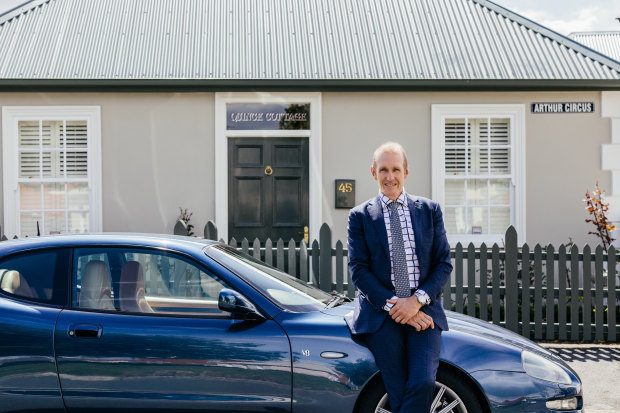
Hobart real estate agent Kim Morgan. Credit: Adam Gibson
On this mid-December afternoon it’s a balmy 26˚C – a good 10 degrees cooler than in my home town, Melbourne. The Derwent River, as vast as a harbour, glistens as Morgan swings past what he says is probably Hobart’s best-positioned apartment, a penthouse on Brooke Street, overlooking the piers and ferry terminal of Sullivan’s Cove. It’s a vista as spectacular as any on Sydney Harbour, for about a tenth of the cost. The penthouse is on the market for $2.5 million, for four bedrooms and two bathrooms over two storeys. Morgan has had an offer from a “local gent”, and yesterday showed through an interested buyer from mainland China. It’s the strongest market he’s seen since the last state boom in 2003.
Little wonder, then, that mainlanders who struggle to enter the property market are increasingly considering the Tasmanian option. Although locals continue to represent the bulk of house buyers, the past two years have seen a dramatic increase in mainland house-hunters. Many are investors who stay put up north, buying something in Hobart to give them a rental income, capital growth and, perhaps, a bolthole for retirement. (In 2017, 21.3 per cent of Tasmanian sales were to interstate buyers, with 44 per cent of those as investments. The number of interstate buyers rose almost by almost 50 per cent from 2016.)
Others, however, are moving here. Morgan tells me of a young Melbourne couple to whom he recently sold a house in Lenah Valley, at the foothills of Mount Wellington, for about $580,000. "He was saying that in Melbourne for him to be able to afford to buy a house, he'd have to be an hour-and-a-half's drive from where he worked. Here it takes him five to 10 minutes."
The state government's "You in a Year" social media campaign is encouraging more people south, with a video promising mainlanders they'll be happier, healthier, more relaxed, "richer in so many ways". While Tasmania's population growth is speeding up, it's still increasing more slowly than that of any other state. The government wants to drive the number of residents from 520,000 to 650,000 by 2050, and attract workers in fields including construction, health care and hospitality.
But its sunny message to the mainland eclipses a gloomier side. While the economy expanded at an average annual rate of 1.3 per cent over the past four years, up from only 0.8 per cent in the preceding three, the state faces persistent social problems. The Tasmania Report 2017, released in December, confirms that Tasmanians remain the nation’s oldest, poorest, unhealthiest, worst educated, most underemployed and most welfare-dependent.
And it’s in Hobart, the state’s largest city where 40 per cent of Tasmanians live, where the gap between the haves and have-nots is increasingly visible. Not everyone can afford to participate in Hobart’s new-found glamour, and as the social and economic divide grows, Hobart risks becoming the proverbial tale of two cities. As Kym Goodes, chief executive of the Tasmanian Council of Social Services, observes, Tasmania is a state that has produced a Booker Prize winner yet has Australia’s lowest proportion of tertiary-educated people; a state renowned worldwide for its produce, yet populated by many who do not eat adequate amounts of fresh food.
Last year, 11,353 houses were sold in Tasmania, the highest number in a decade, with a total value of $3.8 billion. And yet, in releasing the figures, the Real Estate Institute of Tasmania (REIT) cautioned against celebration, warning that booming tourism, growing numbers of university students, more job opportunities and the emergence of Tasmania as a "lifestyle" destination had taken a toll. Demand is outstripping supply and the rental market is particularly overstretched, especially in Hobart, where the vacancy rate dropped late last year to 0.4 per cent, the lowest of any Australian capital. It's not uncommon for real estate agents to face 40 to 50 people at inspections and handle 20 applications for each property. Lower-income families are struggling to find accommodation and cope with rising rents in the tightening market.
“We have run out of houses to sell and we have run out of houses to rent,” says REIT president Tony Collidge. He estimates that greater Hobart urgently needs 5000 new homes to meet demands for affordable rental and private housing.
Meanwhile, attracted by the twin treasures of tourism and cheap real estate, international developers have started circling, bringing visions of glittering skyscrapers, prompting fears that the very things people love about Hobart – its human scale, low rise, heritage character and environmental splendour – will be lost. As Hobart sailor and activist Madeleine Habib put it in a recent edition of Island magazine: "Please don't sell our soul for the tourist dollar; don't let us become a caricature of ourselves."
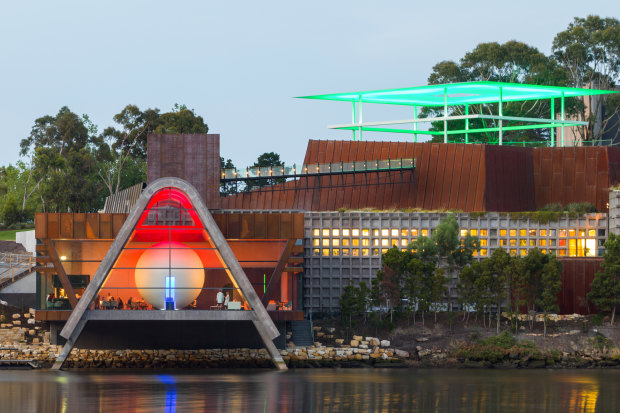
MONA, the museum credited with driving Hobart’s cultural renaissance.
Another day, another flash car – this time a $200,000 Tesla Model X, an electric-powered SUV with doors that open upwards like wings; the kind of vehicle that’ll get you noticed cruising around the outer reaches of Hobart’s northern suburbs. I’m sitting in the back, next to an empty baby seat. In the front passenger seat is Kirsha Kaechele, American artist and curator, better known as “MONA’s first lady”, the wife of David Walsh.
“I’m missing a lot of first-lady attributes,” she teases, sending up the title she’s been bestowed by the local media. “I don’t write Christmas cards and thank-you notes. We’re a failed couple in that regard.”
MONA's publicist is in the driver's seat, nervously negotiating bends, kerbs and roundabouts while Kaechele navigates, taking us into territory where tourists, and many locals, will not venture. We're heading to Bridgewater and Gagebrook, on the opposite bank of the Derwent River from MONA, areas with a rough reputation. (When I mention my trip to Gagebrook to another real estate agent, the response is instant: "You were game.")
MONA is surrounded by suburbs of historical disadvantage. Walsh himself was born and raised in the municipality of Glenorchy, which has the dubious distinction of having more hotel poker machines than any other area in Tasmania, and of being one of Australia's poorest places. It's in the federal seat of Denison, a former Labor stronghold won (and since retained) by anti-pokies independent Andrew Wilkie at the 2010 election.
The northern suburbs exist beyond the so-called "flannelette curtain", the mythical line that separates them from Hobart's hip and cafe-laden inner-city areas of West and North Hobart and the green, hilly loveliness of Battery Point and Sandy Bay. MONA's location, smack in the middle of these northern suburbs, has at the very least lifted their profile – and might have something to do with Glenorchy's creeping gentrification.
Just as Melbourne's "hipster-proof fence" edges further north as inner-city housing becomes absurdly priced, so, too, the "flannelette curtain" is shifting. In Moonah, a few suburbs before MONA from the city, house prices have risen 29.3 per cent in the past two years to a median of $372,000 – and they're on sale for a median of just 16 days. Moonah is now home to such hip cafes as Shake a Leg Jr and restaurants such as St Albi, which serves craft beers and Bloody Mary oyster shooters. While house prices are also wriggling up in Bridgewater and Gagebrook, so far these areas have been immune to the arrival of the cafe crowd.
“The best place to go for coffee in Bridgewater at the moment is McDonald’s,” Kaechele tells me.
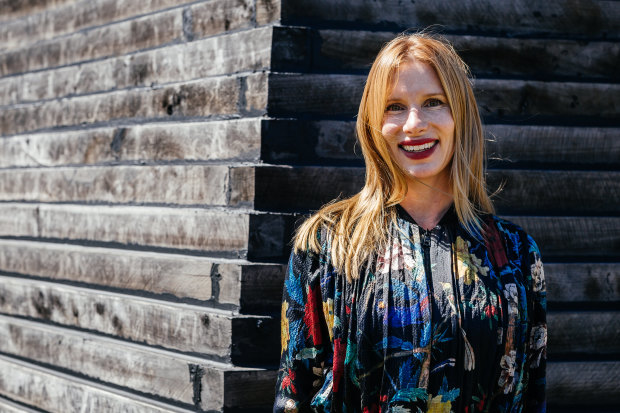
Kirsha Kaechele, dubbed MONA’s “first lady”.Credit: Adam Gibson
Californian-born and Guam-bred, Kaechele has led a life of high adventure. Before moving to Hobart in 2010 to live with Walsh, she ran a public art space in the St Roch neighbourhood of New Orleans, an area of high crime and poverty. When the local kids started hanging around the space, she decided they needed something to do. She honed in on the area's poor eating habits (shown a carrot, the kids had no idea what it was, other than something they'd seen Bugs Bunny munch on) and started an after-school food-growing program which she is now replicating in Hobart.
"I knew that MONA was in a socio-economic demographic which was sort of the equivalent of where I was in New Orleans, albeit the Australian version is way more functional and a lot less dangerous," she says. "But still, the obesity rates in our neighbourhood are just through the roof and there's definitely a class divide in health."
Three years ago, Kaechele launched the 24 Carrot Gardens Project to help local primary schools establish "kitchen gardens" to teach children how to grow, harvest and cook their own fruit, vegetables and herbs. Fifteen schools are currently signed up, sponsored at $35,000 a year by any rich Tasmanian Kaechele could rally, among them environmentalist and Wotif founder Graeme Wood. Walsh himself sponsors a school and foots the bill for two dedicated project managers, and contributes to the salaries of kitchen and garden teachers working within schools.
Gagebrook doesn’t look particularly downtrodden – there are cow-filled paddocks and river views. It’s more a cross of pastoral land and bland suburbia; street after street of modest houses with patchy lawns. Today might be hard-rubbish collection, as there are piles of garbage on the footpaths, including one heap that someone has incinerated. We pass a house with a front yard of beaten-up old cars, including one that looks torched. There are also well-kept homes with pretty gardens. Two weeks before Christmas, I see makeshift decorations, including the words “Ho Ho” spray-painted directly on to a window.
“It doesn’t look like an American ghetto, but I find it a lot more depressing than an American ghetto. It’s super uninspiring,” Kaechele says. “When you live here there’s one way in and out, and where do you go to eat? You can come here to the United petrol station to get some Doritos,” she says, as we pass the servo, “and there’s a fish and chip shop.”
We park in front of Gagebrook Primary, one of the schools in the program, to have a peek at their garden, which encompasses the front lawn. I can see compost bins, fruit trees and vegetable plantings. There’s “everything and anything you can grow”, Kaechele explains, “and foodie herbs, too, that you can’t find at the supermarket.”
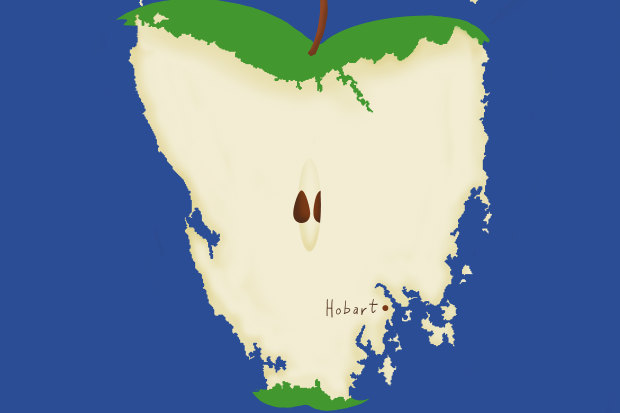
Illustration by Simon Letch.
On our way back to MONA we call in to Bridgewater's Derwent Tavern, a pub with pokies. It's a calculated choice: the pub belongs to the powerful Farrell family, which owns two casinos in the state, including Hobart's first, Wrest Point. By virtue of lobbying successive state governments, the family's company, Federal Group, has the exclusive right to operate all poker machines and casinos in the state until 2023.
Although Walsh made his fortune through gambling and wants to set up a boutique, high-rollers casino at MONA (off-limits to Tasmanians), he has railed against poker machines, calling them "antisocial, unsightly and insidious". Federal Group's chief executive Greg Farrell resisted MONA being granted a casino licence without an extension to his own company's pokies monopoly. In protest, Walsh withdrew his application.
After years of political lethargy, Federal Group is now facing attack from the Labor Party, which is going to the March 3 Tasmanian election vowing to ban pokies in pubs and clubs by 2023. In announcing the move last December, Labor leader Rebecca White spoke of the $110 million lost on poker machines in pubs and clubs the previous financial year. Incumbent Liberal Premier Will Hodgman derided Labor's stance, saying it would cost jobs, and pledged instead to put the licence for pokies in pubs and clubs out to tender and to reduce the cap on pokies statewide.
There's an abandoned fruit and vegetable warehouse across the road from the tavern. Kaechele wants to take over the warehouse and turn it into an art project with an antipokies theme, again engaging local kids. "Federal Group is one of my funders for 24 Carrot," she says. "So there you go, there's the complexity." On an island as small as Tasmania, the web of social connections is snug indeed.
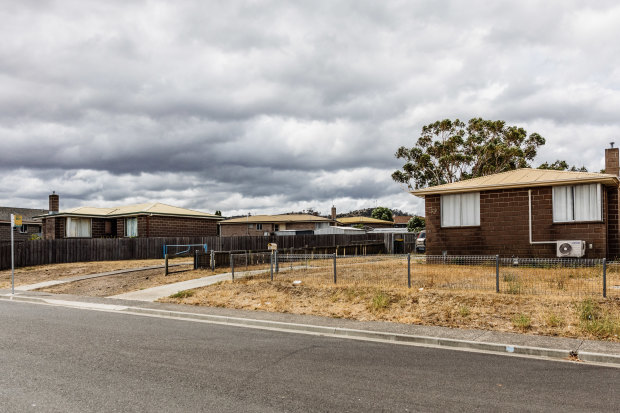
Gagebrook, a few suburbs away from MONA, has not yet gentrified.Credit: Adam Gibson
Driving into Hobart from the airport, I notice two things: the traffic and the cranes. The increase in traffic in recent years is not my imagination – it's front-page news in The Mercury the week I visit. Eavesdropping seems to confirm it: I overhear the woman on hotel reception telling another guest how she used to see five or 10 other cars on her way to work; now there's traffic at 6.30am.
Traffic and cranes are arguably signs of success – or, at the least, of growth. Tourists are visiting in record numbers (1.28 million in the year ending September 2017, up 8 per cent on the previous year) and they’re spending billions. It’s no wonder the government can’t get enough of them and is aiming for 1.5 million visitors a year by 2020.
But for some communities, tourism is of little consequence. “We are not seeing the benefits,” says Hobart-born Alison Stone, who lives in the municipality of Glenorchy. “It’s completely irrelevant to our life.”
A PhD candidate and former teacher, Stone runs after-school programs for six- to 12-year-olds from the area. Three years ago she established the All Stars Club, giving local kids the opportunity to learn swimming, martial arts, boxing, circus skills, singing and drama for the cost of a gold-coin donation – or free if they don't have one. There are more than 370 kids in the club, which she runs as a volunteer. It receives no government funding, though local federal MP Andrew Wilkie personally sends $100 each month. The state Labor Party has promised her a one-off $10,000 grant, which she says could help fund more activities such as mountain bike riding, making use of the municipality's tracts of vacant land.
She's brought me to the Action Fitness Centre in Derwent Park to watch some of the kids from her club go through their paces with the gym's owner, Luke Jackson, a wiry fellow who wrenched himself from family dysfunction and drug abuse to become a professional boxer and Olympian. "Let's go, guys! Uppercuts! Uppercuts! Uppercuts!" he bellows as a motley gang, from a tiny blond boy to a tall teenage girl, all wearing black "Action Jackson" T-shirts, punch imaginary opponents.
"They can learn discipline from me," Jackson tells me, in between shouting instructions. He's a straight shooter in more ways than one. "I found discipline through boxing," he says. "I believe that if I done it through boxing, they can do it through boxing. Boxing got me off the drugs, stopped drinking, stopped partying, stopped stealing, stopped being a rebel."
Jackson is enthusiastic about the changes tourism has brought to the local community. "It's unbelievable," he says. "Moonah is on the rise, we've got a lot of good restaurants this way now, St Albi's being one of them, that's a friend of mine's. Houses are going up."
Are the rising prices hurting locals in any way? "I don't know," he says. "I own my own house, so it's not hurting me."
Tasmania has Australia's highest rate of home ownership: 69.2 per cent own their own home, and more than half have paid it off. "If you can't afford to buy a house here, you can't afford to buy in any capital city," says REIT president Tony Collidge. But for every winner in the real estate market there are people who are being displaced, says Keith Jacobs, director of the Housing and Community Research Unit at the University of Tasmania.
"What I would say as a general rule is that the people who benefit are already well off, and the people who are most disadvantaged will often lose out," he says. "We are hearing a lot of stories of landlords who are putting up rents quite considerably because they can, people being turfed out… and I think those things are going to get worse and worse, because that's the evidence from overseas markets."
Irish-born doctor Christine Boyce has seen the unintended consequences of the real estate boom. Boyce, who moved to Hobart 23 years ago, has worked closely with refugee women settled in Hobart's northern suburbs through Australia's humanitarian Woman at Risk visa. Hobart is one of the "hand-picked" destinations for these most vulnerable of refugees, including Hazara women of Afghanistan, many of whom have witnessed the brutal killings of their husbands. Glenorchy and Moonah used to work well as prime areas of refugee settlement, as they are close to the city's hospitals and other services such as English language classes.
Ten years ago it was still possible for such refugees to afford rents here on their Centrelink payments and have money left over for other necessities. That's no longer the case. "These areas are becoming gentrified," Boyce says. "Rentals are going up and I'm seeing really significant increases in rental-related stress. I certainly have women on my books who are facing eviction notices. They are looking at limited numbers of houses on the market so the level of stress is incredible – and all of this is being conducted in a second language."
Children as young as 10 are relied upon to help the women negotiate the rental market. “I am seeing chronic headaches, I am seeing sleeplessness, a lot of mood disorders and dissociation from everyday life,” Boyce says. “It’s hard to watch women who we have told, ‘Come here, it’s a lovely city, it’s a safe haven,’ and see their health deteriorating because of housing stress.”
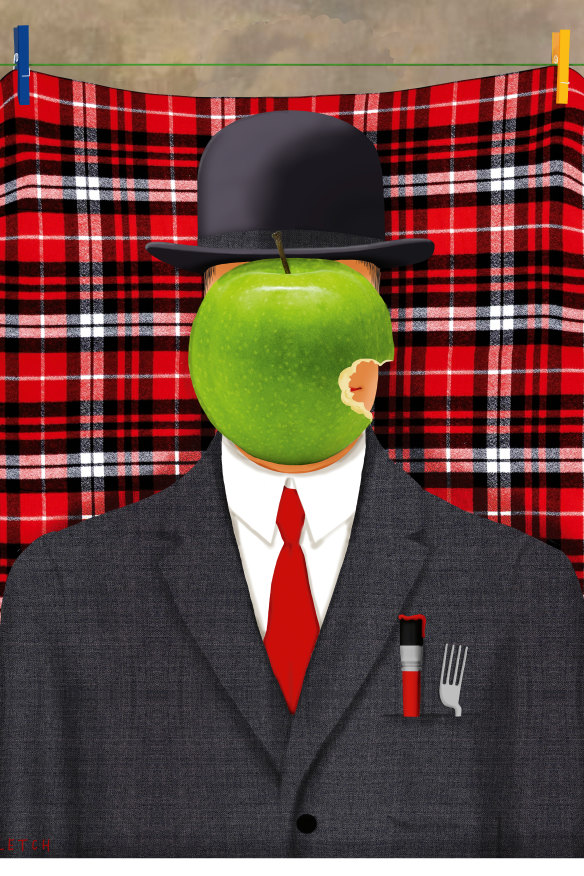
Illustration by Simon Letch.
A few days later I’m heading to New Norfolk, a 35-minute drive north-west out of Hobart, to The Agrarian Kitchen, which won the gong for Australia’s best regional restaurant at the 2018 Good Food Guide awards a mere six months after opening. Before it came along, New Norfolk was synonymous with something far less appealing: its lunatic asylum. Willow Court was Australia’s first custom-built asylum, opened in 1830, and the first institution of its kind to close, in 2000.
I walk through Willow Court’s tall metal gates and up a long wooden ramp to meet Rodney Dunn. He leads me through his airy, light-filled restaurant where wait staff in blue aprons and brisk white shirts are busily setting up for lunch. The restaurant is housed in one of the asylum’s former wards, restored with the help of state and federal government grants. Dunn has retained many of the original features: pressed-metal ceilings and linoleum floors are offset with contemporary touches such as black antler-like chandeliers, long wooden tables and a sleek off-white quartz bar.
In the open kitchen at the restaurant's far end, cooks are chopping and prepping to upbeat dance music as the coals in the wood-fired oven glow. Dunn takes me through his cool rooms and storage areas. He picks up a carrot from a plastic crate and invites me to smell it. He breaks the tip off an asparagus and hands it to me. The flavour is bracing.
"The silver beets are from just down the road," he says, ruffling a thick, gleaming bunch. "Nothing comes from more than 30 kilometres away – max – apart from flour and sugar."
Counter to the fashion for smears, whirls, dollops and foams, Dunn likes to keep things simple, accentuating the flavour of locally sourced produce. A lot of it comes from his own small farm in Lachlan, 10 minutes further into the Derwent Valley, where the scenery becomes abundantly lush and pastoral. There he keeps animals including pigs, goats and poultry that will also sometimes end up in his restaurant or in his cooking classes.
Aged 40, Dunn is a former Sydneysider who worked as an apprentice chef under the formidable Tetsuya Wakuda. While food editor with Gourmet Traveller magazine, Dunn travelled to Tasmania for work and fell in love with the place. In 2007, he and wife Séverine Demanet and their four-month-old son, Tristan, moved south, into an old schoolhouse on a two-hectare property rustling with elms, oaks and poplars. In Sydney, such a place would come with a two-hour-plus commute. The schoolhouse is 45 minutes from Hobart's CBD. Vowing never to open a restaurant, the couple opened a cooking school instead – their old Lachlan schoolhouse was perfect. Nine years later, needing a new challenge, they broke their vow, opened a restaurant in the former asylum, and won national acclaim.
"We were blown away by the space and could instantly see that this would make an amazing restaurant," Dunn says. "The Derwent Valley was also in need of eating places that went beyond takeaway." The locals, he says, have embraced the business. "Even if they're not the sort of people that would come and eat here, they really support what we're doing, they can see the benefits," he says. "There's been lots of shopkeepers saying, 'Oh, since you guys opened it's been so busy, it's been so good for us,' and that makes me happy."
It says something about Hobart's new-found status that The New York Times's Australian arm chose The Agrarian Kitchen for one of its first food reviews. While generally favourable, the reviewer felt haunted by the restaurant's history, and uneasy about Dunn's "bourgeois fantasy" on "land stained by human misery". One's mind can't help but drift to the suffering that once occurred in these rooms, and to the strangeness of their reincarnation, but is a building – and a town – not allowed to transcend its past? Dunn believes so. The reviewer's "bourgeois fantasy" quip disappointed him, especially since his business has created jobs for locals.
“We have been farming and cooking and bringing tourism into this valley for over 10 years, and that speaks for itself,” he says.
I head off to the farm and cooking school 10 minutes down the highway. A picture-book vision unfolds: rolling hills and tall shimmering trees, a family of pigs sleeping in the shade, a nanny goat keeping a watchful eye over her snow-white kids. In the vegetable garden, two young Lachlan locals weed. As a casual job, it beats working in a fast-food joint.
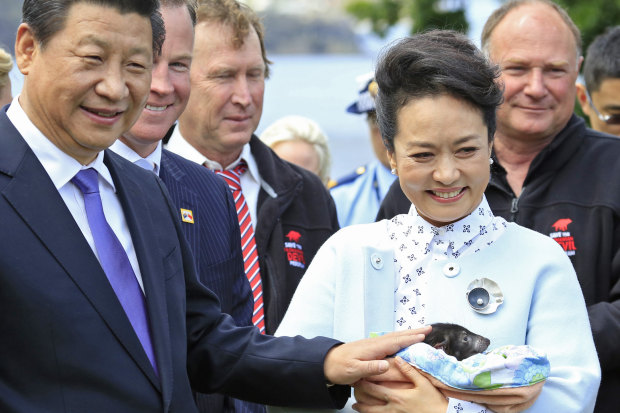
The 2014 visit to Hobart by Chinese President Xi Jinping and Madame PengLiyuan (pictured with a Tasmanian devil) spurred a flood of Chinese tourists.Credit: AAP
Back in the restaurant, a grey-haired woman sitting near me chats to her friends. “New Norfolk is changing,” she says. I assume she means for the better, although it’s hard to tell from her expression.
Much clearer is my impromptu lunch companion “Louis”, a 27-year-old bus driver. “This is paradise,” he says.
By chance, we've ordered the same meal, house-made burrata with cime di rapa (a turnip green), jamon sauce and thick, buttered slices of grilled sourdough. It's an excellent choice: the burrata's creamy heart spills over the bitter greens. While Louis (real name Sun Yu) eats at the communal table, the 15 wealthy Taiwanese tourists he has been driving around dine in a private alcove. They've just arrived from the luxury Federal Group-owned Saffire resort, on the Freycinet Peninsula, where rooms cost from $2000 a night.
From mainland China, Sun Yu moved to Hobart three years ago to study economics at the University of Tasmania. He'd been studying in Melbourne but found the city so crowded with Chinese students he was barely able to practise English. In Hobart he moved into a share house with three "Tassie girls". "They taught me Western ways," he says. "They checked me out first to make sure I wasn't a freak."
Having graduated in 2016, Sun Yu is staying on for another two years, as required by his state-sponsored visa. He loves Hobart’s “tranquillity” but plans to return to Melbourne.
Hobart, he says, is "still not buzzing enough for young people". Work opportunities are limited, he says, and there are no international flights out of Hobart, although the latter will change in late March when a $40-million runway extension at Hobart Airport opens, allowing larger planes that can fly directly to Asia. There are bills to be paid, and while employment in Tasmania is on the rise, it's not growing at anywhere near the rate of the national average, and many of the new jobs are part-time.
Others are making their own opportunities. A new creative class is arriving in Hobart, seizing the baton handed to them by David Walsh and running with it. Zan Boag, editor of New Philosopher magazine, and his partner Antonia Case, editor of Womankind, moved with their three children to Hobart last March from northern NSW's Bangalow, in the hinterland of Byron Bay. "We were looking for a more intellectual environment," Boag says.
They found it in Hobart. Boag was hooked on his first visit to the city in February last year. After giving a talk at the city's long-standing Fullers Bookshop, he went out with some of the locals who'd attended, writers and scientists among them. "I made some wonderful friends," Boag says. "I went back [to Bangalow] and we spoke about it on Saturday morning and by Monday we were in our car driving down. The five of us – and Antonia was seven-and-a-half months pregnant."
The couple have wasted no time contributing to the city's cultural life, opening Poet, an "organic tea atelier" and bookstore, and running a free, monthly, French-style "cafe-philo" at the Salamanca Arts Centre – a grass-roots philosophy forum modelled on those coined by Marc Sautet in Paris in the 1990s. They plan to launch a philosophy festival in Hobart this November.
We meet at Poet, which is housed in a magnificent, heritage-listed Victorian building on Macquarie Street. Inside, pigeonhole-like wooden shelves are stacked with decorative tins of teas with evocative names such as "ginger peach" and "pomegranate white". Classical music floats over a space furnished with rugs and antique wooden tables displaying books with titles such as Alan Jacobs' How to Think: A Guide for the Perplexed.
In Hobart, Boag and Case are conspicuously cosmopolitan. Tall and lean, he wears a straw hat and beige trousers with braces; she wears layers of black, her hair pulled back, face framed by black-rimmed glasses. They've brought their "assistant" along: eight-month-old Huxley, who sleeps in his pram. After 20 years of travelling the world and living in cities including Barcelona and Paris, the couple have bought land in Dynnyrne, just above Sandy Bay.
"It's the first time we've bought anything," says Case. Hobart, Boag says, "really feels like home": small enough to be intimate, big enough to be urban, filled with interesting people, with a great climate and nature on the city's doorstep.
A few days later, at the Tasmanian Museum and Art Gallery, I chance upon Sydney-born artist Fiona Hall and discover that she, too, decamped south 18 months ago. “Everyone’s moving down,” she says, “now that there’s serious culture here.”
Of course, there has always been “serious culture” in Tasmania, it’s just that mainlanders are taking more notice. Clive Tilsley, owner of Fullers Bookshop, has a section devoted to Tasmanian authors – and it’s the store’s most popular. Scanning the bookshelves, the richness of the literary scene is obvious: Booker Prize-winner Richard Flanagan, Heather Rose, winner of the 2017 Stella Prize, James Boyce, Robert Dessaix, Helen Hayward, Nicholas Shakespeare, to name a few. With some pride, Tilsley tells me that when Margaret Atwood toured Australia in 2001, the largest crowd she drew was at Hobart’s Federation Concert Hall, which seats 1100.
Across the road from Poet, on Macquarie Street, is another of Hobart's new breed of businesses: Fico, an Italian-influenced "neo bistro" run by Oskar Rossi and Federica Andrisani. It, too, is in a building rich with history; one of Hobart's oldest, surviving from 1815, and one of the first two made from bricks.
Rossi was born in Hobart and left 11 years ago, aged 20. As an aspiring chef, there simply weren't the opportunities to develop his skills. He moved to Melbourne and worked with Shannon Bennett at the famed Vue de Monde, before heading to Oman, and then on to Europe. He met Andrisani (who is originally from Naples) four-and-a-half years ago at a one-star Michelin restaurant in Italy's north. He enticed her to Hobart in November 2014 and the two stayed there for eight months, running pop-up cafes. They moved briefly back to Italy before returning in February 2016, opening Fico at the end of the year.
"There's a buzz about the place, it's growing, you can feel it everywhere," Rossi says. "When we first came back, Garagistes was closing and it was the only good restaurant in Hobart," he says, referring to the trailblazing restaurant that opened four months before MONA (former co-owner Katrina Birchmeier is now restaurant manager at The Agrarian Kitchen). "And then there was a brief interim before Franklin opened, and since then, you've got Aloft, Templo, Dier Makr, there's actually a food scene. People pouring better drinks, people cooking better food." He has no doubt that if he were an aspiring young chef today, there would be no need to leave.
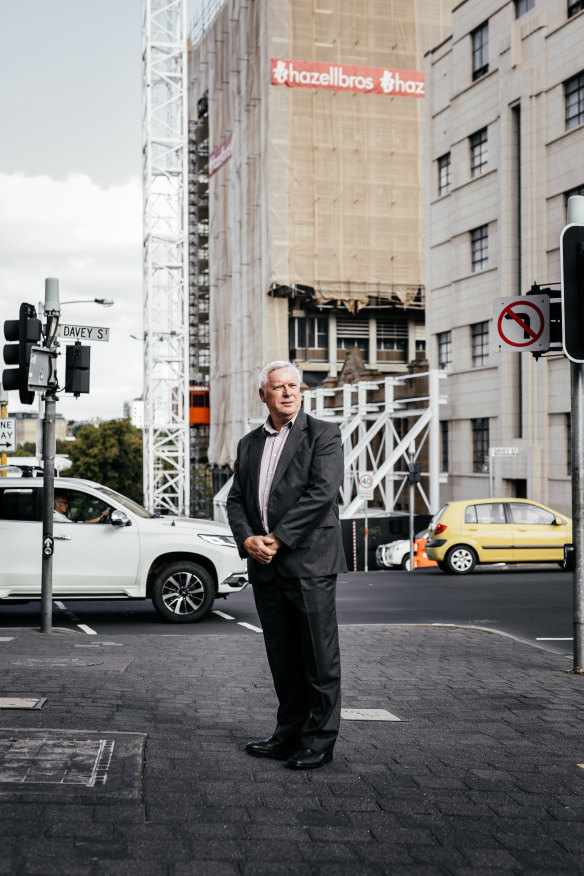
Brian Corr is head of Hobart Not Highrise, a lobby group fighting proposed city skyscrapers.Credit: Adam Gibson
Right now, Hobart stands on the precipice; the very qualities that draw people here are at risk of being compromised. What’s striking is how rapidly new arrivals assume guardianship of their adopted city. Irish-born Brian Corr moved to Hobart two years ago from Perth; in under a year he was president of the community lobby group Hobart Not Highrise, which mobilised in response to two skyscrapers being proposed by the Singapore-based Fragrance Group.
We meet outside the popular Harbour Lights cafe down on the waterfront, the sun beaming down and a fresh breeze blowing. The voice of Frank Sinatra spills onto the street from the cafe’s speakers, competing with raucous seagulls. You could describe Corr and his wife as “climate refugees” from the WA heat, but he also left the West Australian capital because he was tired of living in a city where the dollar was king.
“Best move we ever made, it really is,” Corr says, his Irish burr still strong. “Hobart’s just a fantastic city, and it’s to do with people.” He adds: “It’s very like Dublin.”
Corr wants to keep it that way. He’s now on the frontline defending Hobart from what he sees as inappropriate development. As a retiree, he has the time and he enjoys the work. Skyscrapers, he argues, will ruin the city’s unique character, and there are plenty who agree with him. Outraged by the Fragrance Group’s proposed high-rise hotels, more than 6500 people have now signed the petition against them begun last April on the group’s website. Notably, nearly 400 of the group’s supporters are from the mainland. “We didn’t create the anger, we channelled it,” Corr says.
Two packed public meetings – at the Town Hall and the Hotel Grand Chancellor – made clear the level of opposition against concrete colossi. Hobart Not Highrise wants nothing less than skyscrapers banned. “You allow one, it’s a precedent,” Corr says. “You have to stop the first one … the best cities in Europe don’t have high-rise.”
Hobart's skyline has never risen beyond the 73 metres of the Roy Grounds-designed Wrest Point Casino, which opened in February 1973. At 210 metres, one of Fragrance Group's proposed towers is almost three times the height of Wrest Point; the other, at 94 metres, is 34 metres taller than the Tasman Bridge. Both buildings are proposed for the Sullivans Cove precinct which has a height limit of 18 metres – plus discretion.
“Now, regarding discretion, I always like to use the word reasonable,” Corr says. “If you put 210 metres in an 18-metre area, that’s not reasonable.”
Singaporean interest in Hobart is strong, with Fragrance Group having four hotel developments in the pipeline, including one on a midtown 3500-square-metre site that cost less than $4 million. Another Singapore-based company is building the 63-metre-high Palace Hotel in Elizabeth Street, near the bus mall. The CBD limit is ostensibly 45 metres, but Hobart City Council approved the hotel after the developer knocked the height down from 73 metres.
The planned Fragrance towers are at the city's edge, near main roads, in areas which could perhaps support high-rise. "It's a precedent," Corr stresses. "Put one in and you can't stop the next one. The council has lots of grounds to say no. The problem then would be if the state government declared it a major project and said yes."
The future skyline of Hobart is shaping up as another key issue at the March 3 state election. Hobart Not Highrise is concerned that the state government's proposed major projects' law is so broad and poorly defined that it hands the planning minister the power to bypass councils, allowing skyscrapers to be built by canny developers exploiting loopholes.
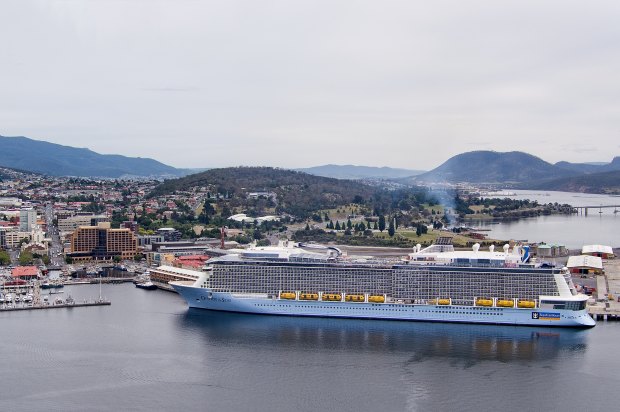
The cruise ship Ovation of the Seas arrives in Hobart in 2016; such tourist-filled vessels are a boon for Tasmania’s economy.
On my return to Melbourne, I ring the Tasmanian Liberal Premier, Will Hodgman, and ask, among other matters, about the pressure being brought to bear on Hobart's skyline by international developers. "It's symptomatic of an economy that's strong," he says. "When we came into government we proudly declared that the state was open for business, and it's not surprising given the high levels of confidence and interest in our state that international investors are looking to Tasmania. We need to strike the right balance, work with developers, understand their needs but also convey our very strong view that what makes Tasmania so special is worth protecting."
In the space of a few years, Tasmania has gone from Apple Isle to Isle of Dreams. The question, now, is whose dreams will prevail?
To read more from Good Weekend magazine, visit our page at The Sydney Morning Herald or The Age.